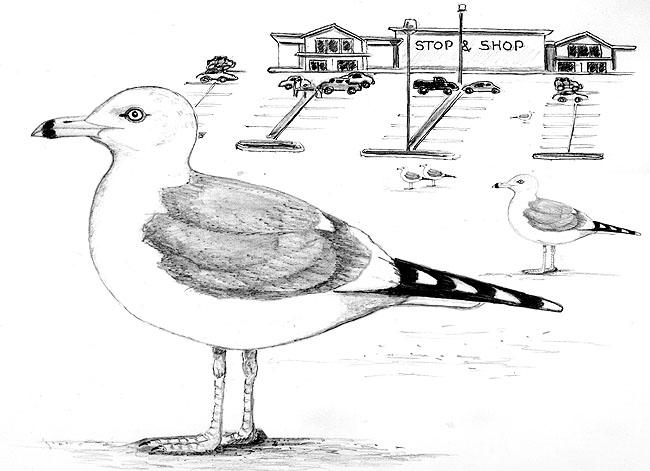
Dear Bird Folks,
While I was sitting in the Stop & Shop parking lot last week, waiting for my wife to finish shopping, I began to notice the gulls. There were the usual Herring Gulls, but there were also several gulls that looked just like Herring Gulls, only smaller. These weren’t baby Herring Gulls, were they?
– Ed, Truro, MA
You are brave, Ed,
I’m sure there are a lot of people who might criticize you for not going into Stop & Shop and helping your wife with the shopping, but not me. I think you are a brave man for letting her go in there alone. The last time I didn’t go into a grocery store with my wife, she came out with two bags of groceries and a brand new outfit. I don’t know how she managed to find a clothing department in a grocery store, but she did. After that experience I always go in with her. Don’t get me wrong; it’s not my business if she wants to buy her clothes in a grocery store, but I swear this particular outfit smelled like liverwurst. My wife denies it, but she can’t explain why dogs follow us whenever we go out.
I’m glad you noticed the gulls, Ed. Gulls are among the most abundant birds in our area, yet most folks simply call them “seagulls” and never bother to notice that we have many different species. Good for you. Now for the bad news: you didn’t see “baby” Herring Gulls. Birds are pretty much fully-grown the day they can fly. Consequently, if you see a large bird and a smaller bird, and both birds can fly, they aren’t related. In this case, the “baby” Herring Gulls you saw were actually Ring-billed Gulls. Ring-billed Gulls are extremely common Cape birds and look very similar to Herring Gulls. Ring-bills also love to hang out at grocery store parking lots, just in case someone drops a bag of chips or is wearing an outfit that smells of liverwurst.
About thirty percent smaller than the ubiquitous Herring Gull, the Ring-billed Gull is equally widespread and may be the most common gull in North America. In addition to the size difference, adult Ring-billed Gulls have yellow feet and legs while Herring Gulls have pink legs. They also don’t have the Herring Gulls’ signature red spot on their beaks. Instead, and true to their name, ring-bills have a black ring that wraps around the bill, near the tip. And if you look closely, you’ll also see they have a bright red ring around the edges of their eyes. (The red around their eyes is something they must have picked up from NBC’s Bob Costas.)
Like many birds with white feathers, ring-bills suffered when idiots thought feathers looked better on humans than they do on birds. Fortunately, that nonsense has stopped and the gulls have recovered nicely. A major factor in their comeback has to do with their flexibility. I’m not talking about yoga-type flexibility, but the ability to quickly ladapt to changes in their environment. Many other birds are dependent on certain types of food, but ring-bills will eat just about anything. Well, anything except maybe lima beans, and who can blame them?
By examining this gull’s pellets (pellets are coughed-up bones, shells and other indigestible matter) researchers have found that ring-bills consume over ninety different food items. As you might expect, fish is high on their list, but they also eat other foods including grain, insects and small mammals. In rural areas ring-bills regularly follow the farmer’s tractor, picking up grasshoppers, crickets and other critters that are forced out of hiding by the plow. And unlike most humans, ring-bills actually look forward to rainy days. When it rains worms come to the surface to play in the puddles, and when they do the gulls are waiting for them. In addition, ring-bills happily take advantage of our sloppy ways and scoop-up whatever we spill. Along the coast ring-bills are sometimes accused of stealing food off the blankets of beachgoers. If this is a problem for you, I suggest you walk farther down the beach and casually scatter popcorn on somebody else’s blanket. It works for me every time, plus it’s kind of funny.
Ring-billed Gulls can be seen on Cape Cod anytime of year, but in the summer we see the duller immature birds. Breeding adults leave our area to make new ring-bills. They nest in large colonies, often on protected islands on inland lakes. The birds like these islands so much that they typically return to the exact same island and to the exact same spot year after year after year. While their choice of breeding grounds might not be very adventurous, their nesting habits sometimes have a little spice to them. Normally, a ring-bill female will lay two-to-four eggs in her nest, but occasionally a lot more eggs are found. This is the result of a male mating with two females. When this happens both females lay their eggs in the same nest and then all three birds tend to the babies. It seems odd for a male to breed with two females but the ladies don’t seem to mind (and you can bet he doesn’t either).
I’m glad you noticed the two different gulls in the parking lot, Ed. Just keep in mind the clues I gave you earlier are only helpful in distinguishing adult Herring Gulls from adult Ring-billed Gulls. The same hints won’t work for the duller juveniles. For young birds, size is the best clue. You could also try tossing out a few lima beans. If the gulls ignore them, they are ring-bills. But if they chow them down, they are Herring Gulls. Humans have yet to discover a substance Herring Gulls won’t eat.